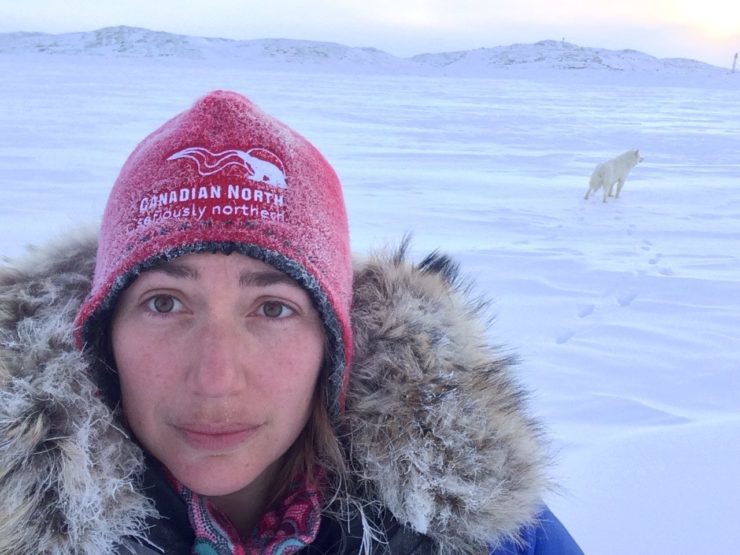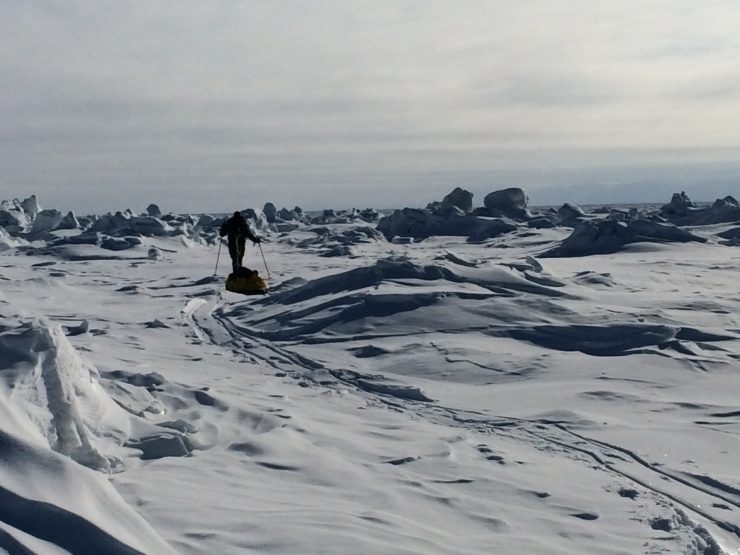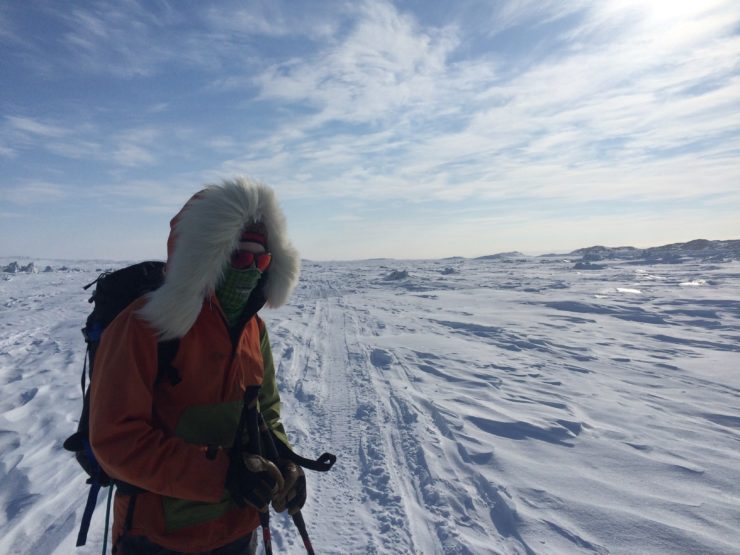Adventure narratives thrive on the nearness (or near miss) of doom’s heavy paw, but Eva Holland gives readers something other than a saga of suffering and survival in her recent account of her slog across the frozen sea near the Arctic Circle.
Holland, a freelance writer and editor based in Canada’s Yukon territory, has routinely ventured into harm’s way: She’s clambered cliff walls to overcome her fear of heights on behalf of an article on “Exposure Therapy” (subtitled: “The Fine Art of Scaring the Shit Out of Yourself on Purpose”). She’s subjected herself to the world’s longest canoe and kayak race under the aspirational name of Eva “Hellbent” Holland. She’s scouted a ferocious footrace in “Mount Marathon Is the Toughest 5k on the Planet” — furnishing her story with details like, “It often leaves finishers dripping with blood or with gravel shrapnel embedded in their butts and legs.”
So if Outside magazine dispatched her to an Extreme Polar Training Course on Canada’s Baffin Island expecting her to file a travelogue of trials and tribulations, well, they were in for a surprise. Instead, she sent back poetry. (OK, there are some trials and tribulations too.)
It’s Holland’s inveterate sense of humor that endears her narrative to daredevils and risk-averse readers alike.
Holland readily admits that as she stumbled out to her tent that first night in minus-15 weather, she was “intending to suffer.”

In writing that’s as clean as new snow, Holland says, “This urge to fling yourself into a sufferfest and come out on the other side still animates plenty of people.” But, she soon discovers, the expectation that she was “about to endure two weeks of relentless discomfort” was misplaced.
As Holland puts it, the founders of the Northwinds Expeditions program —a mother-and-daughter duo named Matty McNair and Sarah McNair-Landry — “don’t traffic in suffering for its own sake.” Instead, they focus on fun.
Holland translates “fun” for those of us who think an amble through the Arctic sounds like anything but: “To thrive, Matty believes, you have to find the beauty and wonder in polar travel instead of dwelling on the obstacles and suffering.” Holland explains her instructors’ methods as “a sequence of interlocking systems intended to prevent any eating-of-boots or enduring-of-hardships.”
While “interlocking systems” sounds fantastic, I think it’s Holland’s inveterate sense of humor that endears her narrative to daredevils and risk-averse readers alike.
Her story is sprinkled with cheeky bits. For example, Holland quips: “The history of polar exploration, after all, is a story of pain. White men, many of them British, battered their way through or across the ice that covers the top and bottom of the world in a parade of frostbite and scurvy. They froze. They starved. For the most part, they ignored the accumulated knowledge of the indigenous peoples they met in the Arctic. Instead, they ate their dogs, their shoes, and sometimes each other.”
Taking this “beauty and wonder” stuff to heart, Holland describes the world around her with a poet’s ear and a painter’s eye.
Holland confesses she once wrote a satirical television script about a “Survivor”-style show set in northern Canada. “The built-in joke, she said, “was that survival can be a lot more challenging, and a lot less visually appealing, in the cold…I envisioned a show filled instead with parka-clad characters, fur-rimmed hoods cinched tight, so bundled up they were unable to effectively whisper and plot.”
If there is built-in hilarity to enduring, Holland finds it again in itemizing the challenges of her final exam -- a 72-hour journey skiing across the ice with her two classmates. She describes their objectives: “dodging dehydration, frostbite, hypothermia, injury, navigational error, loss of critical gear, fuel spills, a tent fire, and a good old-fashioned societal breakdown in our civilization of three.”
But perhaps all this mirth is Holland’s way of counterbalancing her bracing, beautiful descriptions. Taking this “beauty and wonder” stuff to heart, Holland describes the world around her with a poet’s ear and a painter’s eye, showing us “ocean’s rough frozen skin,” noting that “the ice creaked and boomed as it shifted in the grip of the tide” and letting us see how “the sun sank toward the horizon ahead of us, turning the snowscape pink and orange.”

And yet, discovering the Arctic’s wonders and beauty were at times as arduous as trudging into headwinds with a 40-pound sled. Holland writes: “I tried to focus inward, tried to channel Matty and see each valley of powder that I blundered through, each tall line of sastrugi as a beautiful little challenge. I tried to think of the journey not as a struggle but as a game and to find joy in each tiny victory.”
Other times, joy and awe are not a struggle at all, as when the heavens dazzle her on a late-night pee:
“The usual dark bowl filled with stars greeted me, but this time it was ribboned with the vivid green of the northern lights, each stripe undulating from horizon to horizon. I craned my neck back and stared, and I forgot about the cold, or the risk of my mitts blowing away while I fumbled with zippers, or the hassle it would be to get my sleeping bags aligned just right again. … I watched the sky ripple and burn.”
For those among us who haven’t discovered our deep desire to be out there on the ice, Holland generously provides the feeling of not just surviving but enjoying an inhospitable environment replete with moments of humor, wonder and polar poetry.



